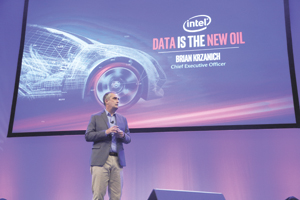Autonomous Vehicles to Run on Data

This story appears in the February 6 print edition of iTECH, a supplement to Transport Topics.
The financial arm of computing firm Intel is investing $250 million in autonomous vehicle technology, targeting three areas that the company’s leader believes will place Intel at the forefront of an approaching wave of change in transportation.
“Just as oil has transformed our world over the last century, data is poised to transform our world for the next hundred years — and beyond,” Intel CEO Brian Krzanich said in a blog post on the company’s webpage, posted in November to coincide with the announcement of the investment.
“When it comes to the car of the future and automated driving experiences, data is literally the new oil,” he said. “Data has the potential to radically change the way we think about the driving experience: as consumers, as automakers, as technologists and as citizens of our communities.”
BEST OF FEBRUARY iTECH: More stories, columns
In a statement, Intel said the initiative is being handled by its Intel Capital financial division, which since 1991 has invested more than $11.8 billion in nearly 1,500 companies in 57 countries. Of those companies, 214 have gone public globally and more than 400 were acquired or included in a merger, Intel said.
This autonomous vehicle initiative, Intel said, will “drive the development of technologies that push the boundaries on next-generation connectivity, communication, context awareness, deep learning, security, safety and more.”
Drilling down into specifics, the statement highlighted the development of the Internet of Things, or IoT, in transportation; safety technologies that can help mitigate risk while also improving mobility and efficiency, and companies that harness data to improve the reliability of automated driving systems.
All of this adds up to what Krzanich described as an “enormous flood of data driven by the proliferation of smart, connected devices.” But he noted that Intel is focused on three key areas: technical data, crowdsourced data and personal data.
Technical data, which he described as “inside-out” data, is collected from sensors on the vehicle that interpret the difference between a child or an animal, or a fallen branch and a traffic cone, and directs the outward decisions and movements of the car, Krzanich said. “This data takes an incredible amount of computing power, and whoever has the best data can develop the best artificial intelligence tools of machine learning, deep learning algorithms and data analytics,” he said.
The second type of data, societal and crowdsourced data, he describes as “outside-in” data. This includes information collected from “the world around the vehicle,” including traffic data, that influences how vehicles move between destinations. “With this data, whoever has the most data will be able to develop the best applications,” he said.
Lastly, there is personal data, including data that tracks how many people are in a car and each passenger’s preferences for music, stores, brands and more. Wearables and other sensors inside the car can monitor behavior and emotional and biometric status to increase safety and security.
“Whoever has the most personal data will be able to develop and deliver the best user experience,” Krzanich said.
And users are expected to generate a lot more data within the next few years.
“In 2016, the average person generated 650 megabytes of data a day — through use of their PCs, mobile phones and wearables. By 2020, projections show that the average person will generate 1.5 gigabytes of data a day,” Krzanich said. While that’s an impressive increase in less than four years, “it pales in comparison to what we’re about to see in autonomous vehicles.”
Krzanich said autonomous vehicles will propel this surge in data due to the various components they’ll use to communicate with each other and surrounding infrastructure — including cameras, radar, sonar, GPS and Lidar.
With the information captured by those sensors, each autonomous vehicle will be generating about 4,000 GB — or 4 terabytes — of data a day, he said.
Put another way, Krzanich said, every autonomous car will generate the data equivalent of almost 3,000 people. “Extrapolate this further and think about how many cars are on the road. Let’s estimate just 1 million autonomous cars worldwide — that means automated driving will be representative of the data of 3 billion people.
“The automotive ecosystem has an incredible opportunity to use data to drive insights, take action on new business opportunities, and even create a safer, less contentious world,” he added. “Data is truly the new currency of the automotive world.”
The autonomous vehicle initiative tracks with recent moves Intel has made, ZDNet.com reported. In May, Intel acquired Itseez, a computer vision firm with an expertise in embedded and specialized hardware used in IoT market segments such as the automotive sector. The company also has made investments to bolster automotive capabilities such as functional safety and over-the-air software management.
In July, Intel announced it was teaming up with BMW and Mobileye to deliver fully autonomous vehicles by 2021. And in September, Intel joined a group of automotive manufacturers and networking equipment makers to form the 5G Automotive Association.
Krzanich also discussed the initiative during a Nov. 15 appearance at the AutoMobility conference, which was held in connection with the Los Angeles Auto Show.

